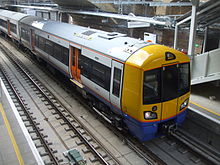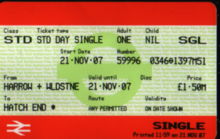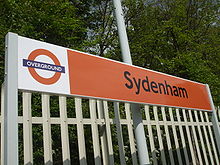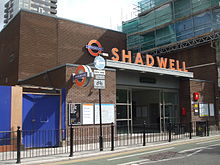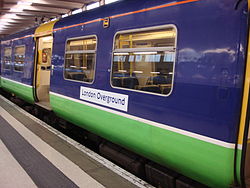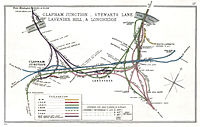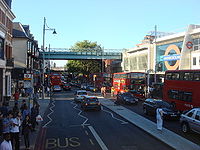- London Overground
-
Not to be confused with London Underground.
London Overground 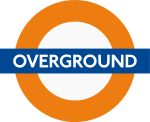
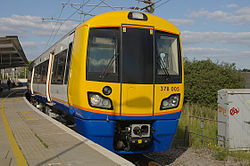
Info Owner Rail for London Ltd; part of Transport for London (TfL) Locale Greater London; Three Rivers; Watford, UK Transit type Commuter rail
Suburban railNumber of lines 5 Number of stations 78 (83 in October 2012) Daily ridership over 200,000[1] Website www.tfl.gov.uk/overground Operation Began operation 2007 Operator(s) Operated by LOROL under contract to TfL, 11 November 2007–2014 (optional extension to 2016) Technical Track gauge Standard London Overground (LO) is a suburban rail network in London and Hertfordshire.[2] It has been operated by London Overground Rail Operations since 2007 as part of the National Rail network, under the franchise control and branding of Transport for London (TfL). It consists of five lines: the East London Line; the Gospel Oak to Barking Line; the North London Line; the West London Line and the Watford DC Line.[3] From late 2012 a sixth line, the South London Line, will be incorporated into the Overground system.
Contents
History
Background
Rail services in Great Britain are mostly run on a system of rail franchises and operated by a number of private train operating companies, marketed together as National Rail.
A pilot scheme was launched in 2003 to bring National Rail services operated by multiple companies under one branding umbrella within London. Using the Overground Network brand, TfL introduced consistent information displays, station signage and maps on selected routes in South London. Although this pilot was purely an exercise in branding, it was the first instance of TfL having a visible influence over National Rail services in London. The Overground Network pilot has since been withdrawn.
In January 2004 the Department for Transport announced a review of the rail industry in the United Kingdom.[4] As part of that review, proposals were put forward by Transport for London for a "London Regional Rail Authority" to be established, which would give TfL regulatory powers over rail services in and around Greater London.[5]
A result of this consultation was the transfer of part of the Silverlink rail franchise to TfL control. This is to date the only agreed movement towards establishing a London-wide rail authority.[6]
The Silverlink franchise had two areas of operation: Silverlink County (regional services from Euston to Northampton, St Albans Abbey, Bletchley and Bedford); and Silverlink Metro (services mostly within the London urban area). When the franchise was split up in 2007, County services were taken over by the London Midland franchise,[7] and the Metro services came under TfL control.
Initial announcements
On 20 February 2006, the Department for Transport announced that TfL would take over management of services then provided by Silverlink Metro.[8] Tenders were invited from potential contractors to operate the service under the provisional name of the North London Railway. On 5 September 2006, London Overground branding was announced, and it was confirmed that the extended East London Line would be included.
Launch
Class 378 Capitalstar 378017 at Whitechapel
On 11 November 2007, TfL took over the franchise for the operation of trains on North London Railway routes formerly of Silverlink Metro.
The official launch ceremony was on 12 November 2007 at Hampstead Heath station by the then Mayor of London Ken Livingstone, with a later media event on the disused bay platform at Willesden Junction station.
The launch was accompanied by a marketing campaign entitled "London's new train set", with posters and leaflets carrying an image of a model railway retail package containing the new Overground trains, tracks and staff.[9]
At the launch, TfL undertook to revamp the routes by improving service frequencies, staffing all stations, improving station facilities, introducing new rolling stock and allowing Oyster card pay as you go to be used throughout the network from the outset.[10]
All stations were "deep-cleaned"[11] following the TfL takeover, and the Silverlink branding was removed. Station signage has been replaced with Overground-branded signs using TfL's corporate New Johnston typeface.[10][11]
On 15 April 2009 the North London Line platforms at Stratford moved to new high-level platforms 1 & 2 from the old low-level platforms 1 & 2, the latter being made available for the DLR's Stratford International service. Platforms 1 and 2 comprise an island platform with step-free access to platform 12 and the subway linking to platforms 3 to 11.
On 27 September 2009, Imperial Wharf station opened on the West London Line, between West Brompton and Clapham Junction.
East London Line extension
On 27 April 2010 the East London Line became part of the London Overground network when the Phase 1 extension to the line was completed.[12] The former London Underground line has been extended northwards (mostly along the former Broad Street viaduct of the closed North London Line) to the re-opened Dalston Junction, and southwards to new termini at Crystal Palace and West Croydon by using part of the existing Brighton Main Line.
The service began with a limited "preview" service between Dalston Junction and New Cross / New Cross Gate,[13] with the line coming into full operation between Dalston Junction and West Croydon/Crystal Palace on 23 May.[14] On 28 February 2011, the section of the line between Dalston Junction and Highbury & Islington was opened to the public. In attendance were the Mayor of London, Boris Johnson, and London Underground's Managing Director, Mike Brown. All trains from Highbury & Islington terminate at Crystal Palace/West Croydon, while trains from Dalston Junction terminate at New Cross[15] and, from late 2012 onwards, Clapham Junction via Surrey Quays.[16] TfL said in November 2010 that ridership on the new East London line was ahead of forecast at 92,000 a day, and that patronage at Surrey Quays had "gone through the roof".[17]
The incorporation of the East London Line into the London Overground network has added substantial sections of line that are in tunnels, including the historic Thames Tunnel, the oldest tunnel under a navigable river in the world. A peculiarity of this part of the network is that at Whitechapel the London Overground line runs below the London Underground line.
Operator
 London Overground Rail Operations Limited
London Overground Rail Operations Limited
The Overground is operated by a private company, LOROL. Following a model similar to that already used for the Docklands Light Railway, TfL invited tenders for operation of the Overground. Unlike National Rail franchisees, TfL would set fares, procure rolling stock and decide service levels. The operator would take an element of revenue risk: TfL takes 90% of the revenue risk, 10% of revenue is retained by the operator, and the operator is responsible for revenue collection.
The tenderers were MTR Laing (a 50:50 joint venture between MTR Corporation and Laing Rail), Govia, National Express Group (the operator of Silverlink), and NedRailways. In December 2006, this was narrowed to Govia and MTR Laing, who were selected to submit their 'best and final offers',[18] and on 19 June 2007 it was announced that MTR Laing had been selected.[19]
The contract was signed on 2 July 2007, for seven years with the option of a two-year extension.[20] In preparation for the launch of the Overground, MTR Laing renamed itself London Overground Rail Operations Ltd (LOROL).
In December 2007, Henderson Group, the parent company of John Laing plc, announced the sale of the Laing Rail division, which comprises half of LOROL, Chiltern Railways, and a stake in the Wrexham & Shropshire open-access railway operator. In April 2008, Laing Rail was bought by the German Government's rail operator Deutsche Bahn, which now holds a 50% stake in LOROL.[21] The price was said to be around €170 million.[22]
Current system
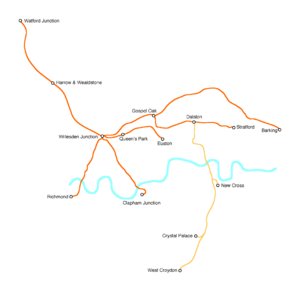 Initial London Overground network from November 2007 (orange) and the East London line in 2010 (light orange).[23]
Initial London Overground network from November 2007 (orange) and the East London line in 2010 (light orange).[23]
Introduction
The initial network, service levels and timetables were a continuation of Silverlink Metro services. As the Overground name implies, the majority of the network is above ground, mostly consisting of railway lines connecting together different areas outside Central London, with a considerable portion of the network in Zone 2. The network also uses Euston in central London, the southern terminus of the Watford DC Line.[3][24]
Routes
The Overground consists of the following lines:
- East London Line – Highbury & Islington to West Croydon/Crystal Palace; Dalston Junction to New Cross.
- Gospel Oak to Barking Line – Gospel Oak to Barking
- North London Line – Richmond to Stratford (the Stratford to North Woolwich section closed on 9 December 2006).[25]
- Watford DC Line – Watford Junction to Euston
- West London Line – Clapham Junction to Willesden Junction
- South London Line (from late 2012) - Dalston Junction - Clapham Junction
The network interchanges with the Bakerloo, Central, District, Hammersmith & City, Jubilee, Northern and Victoria tube lines and the Docklands Light Railway. The Overground lines appear with the Underground lines on the standard Tube maps issued by Transport for London,[26] and a separate map of the system is also available.[27]
Much of the Overground passes through less affluent areas, and is seen as contributing to their regeneration.[28] The North London and Gospel Oak to Barking lines were previously considered by the Transport Committee of the London Assembly to be neglected and not developed to their full potential.[29]
Service frequencies
As of May 2011[update], these are the typical service frequencies on individual lines:[30]
- North London Line – six trains per hour between Stratford and Willesden Junction, with four continuing to Richmond and two to Clapham Junction. Eight trains per hour at peak times.
- West London Line – four trains per hour (two starting or ending at Stratford).
- Gospel Oak to Barking Line – four trains per hour.
- Watford DC Line – three trains per hour.
- East London Line – four trains per hour serving each of the southern termini, providing 12 trains per hour through the central section from Surrey Quays to Dalston Junction. Eight trains per hour from Dalston Junction to Highbury and Islington.
- South London Line (from late 2012) - four trains per hour from Dalston Junction to Clapham Junction via Surrey Quays.[31]
Stations
The Overground serves the following stations:
Current operations
London Overground Rail Operations Ltd (LOROL) has its head office in Swiss Cottage, where executive functions and staff training are carried out. Also here is Operations Control, which manages day-to-day operations. LOROL maintains its rolling stock from depots at Willesden Junction and New Cross (newly built for the extended East London line); it also uses several satellite locations for stabling trains, including Stratford railway station and Barking Depot in East London (Barking is a central depot for the National Express Group Franchise C2C). Train crew are based at several station locations across London, including London Euston, Willesden Junction, Watford Junction, New Cross, Stratford and Gospel Oak.
Ticketing
Ticketing on the Overground uses a mix of paper and the Oyster Card electronic smart card. As with all National Rail and TfL services in London, passengers can use a Travelcard (daily, seven-day, monthly or annual); as on other National Rail Services in London, paper single, return and cheap day return tickets priced under the zonal fare scheme are also available. In addition, TfL permits the use of Oyster "pay-as-you-go" (PAYG).
As part of an effort to improve safety and protect revenue, TfL has announced that it will introduce ticket barriers at a number of stations. The stations that did not have barriers when TfL took over the line have been fitted with standalone Oyster Card readers similar to those at ungated Underground and DLR stations. The validator at Blackhorse Road which previously was needed to enter/exit the Oyster card system when using the line is now disused.
The ticket stock for the Overground continues to be common National Rail stock, as Overground services remain part of the National Rail network, but sometimes with a large TfL roundel in the centre and the repeated legend "Rail Settlement Plan" in a light green background.
Ticket pricing
Oyster PAYG is charged on the same zone-based rules as for the Underground and the Docklands Light Railway. Stations outside Greater London, except for Watford Junction, are included in the newly created Travelcard Zones 7-9, while Acton Central, Hampstead Heath and Willesden Junction were re-zoned on 2 January 2008 (from 2 to 3, 3 to 2 and 3 to 2/3 respectively), which had the effect of reducing some zone-based fares.[32]
Paper tickets are charged on the same zone-based rules as for Underground and DLR paper tickets, which were expanded to take in the extra zones covered. Watford Junction has its own specific price scale. In all cases, paper tickets are significantly more expensive than using Oyster PAYG.
Performance
Although branded as a TfL service, the Overground remains as, and is monitored for performance as, part of the National Rail network (unlike the Underground). The most recent figures released by the Office of Rail Regulation (ORR), for January to March 2011, showed that it had achieved 95.9% of the Public Performance Measure (PPM) target for punctuality and reliability set by the ORR. This was above the average PPM for all London and the South East railway companies. The MAA of the PPM for the 12 months to 31 March 2011 was 94.8%.[33] TfL, in conjunction with the Massachusetts Institute of Technology, has investigated the use of data from the Oyster smartcard ticketing system to measure the performance of the Overground explicitly from the passenger perspective.[34]
In the Spring 2010 National Passenger Survey, conducted by Passenger Focus, London Overground received the lowest overall satisfaction rating of any UK train operating company[dated info], at 72%.[35]
Branding
The public presentation of the Overground is visually associated with existing TfL design standards, using similar graphic design elements to those used on Underground publicity, signage and other elements, drawing on the design heritage of Frank Pick. These design standards will be applied to the new fleet of trains.
The routes are branded with a new version of the roundel, the iconic bar-and-circle symbol associated with transport services in London. The Overground version consists of an orange ring with a blue bar.[36] The roundel was adopted from an earlier design by the London Passenger Transport Board in 1933 and which has spawned many variations applied to succeeding operations.[37] The current TfL versions use a hollow circle or ring rather than the original solid circle.
In common with other TfL services, the Overground is denoted by a designated sector colour, a vivid orange (Pantone 158C).[36] Similarly to the presentation of the DLR, the Overground is shown on Tube maps as a double stripe rather than a solid line, to denote its status as a service that is not an Underground line.[26]
Corporate signage, stationery and literature use the New Johnston typeface in common with other TfL services.[36] A few refurbished stations on the reopened East London line now display the station name in large orange three-dimensional upper-case letters.
Rolling stock
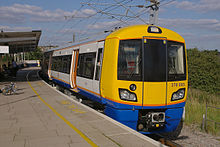 A London Overground Class 378 Capitalstar in August 2009
A London Overground Class 378 Capitalstar in August 2009
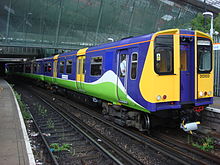 Former Silverlink Class 313s have now been withdrawn from London Overground services
Former Silverlink Class 313s have now been withdrawn from London Overground services
Since London Overground took over operations from Silverlink, Transport for London has been pursuing a programme of rolling-stock replacement over three to five years. From 2009, brand-new Class 378 Capitalstars built by Bombardier Transportation have been introduced on the electrified lines. The North London Line has 24 three-car units,[2] and after platform extensions the North London Railway fleet will be extended to four cars in 2011. The East London Line is being initially operated with 20 four-car units, with three extra trains due to be introduced.[38]
The new Class 378 electric trains were officially unveiled at Willesden Junction station on 13 July 2009. They include a number of "Tube-style" features, including longitudinal seating and increased standing room to provide a high-capacity metro service. The trains have walk-through open carriage interiors and air conditioning.[39][40] The first Capitalstars began passenger operation in July 2009.[41]
The new trains are leased from a newly-formed Rolling Stock Operating Company (ROSCO) named QW Rail Leasing, the lease running until 2027. TfL had planned to buy the new Class 378 EMU fleet outright, but in February 2008 it announced that it would lease the trains instead in order to free up the £250 million capital cost of purchase, combined with reducing the risk of making a loss through any future sell-on of the fleet.[42]
The class 378s were introduced with success on most of the London Overground but there were some issues and delays. The 4-car 378 units for the Watford DC Line were delayed due to problems operating the trains as driver-only operated, due to safety concerns about blind spots on the CCTV system that allows the driver to see the passenger doors close. The Class 170 had technical issues that have now been resolved. But as of October 2010, the new rolling stock has completely replaced the older Class 313 EMU, Class 508 EMU and Class 150 DMU units previously operated by Silverlink, apart from the three Class 508 units withdrawn in late 2008. All the older rolling stock has been cascaded to other train operating companies, such as First Capital Connect, First Great Western and Merseyrail.
The East London line, previously operated with London Underground A60 and A62 Stock, was temporarily closed for rebuilding and is now operated with new Class 378 Capitalstar units.
Eight two-car Class 172/0 units were ordered by Angel Trains on behalf of TfL in November 2007,[43] and London Overground will lease the units from them.[44] Electrification of the GOBLIN line is advocated by TfL, local boroughs and passenger groups, but has not been included as part of Network Rail's Route Utilisation Strategy for the Cross London Route.[29] From 2010, TfL started using new two-car Class 172 Turbostar diesel trains.[45]
All of the 172/0 units (numbers 172001 to 172008) have entered service for London Overground.[46]
If the plan to replace the Watford DC Line with a Bakerloo line service to Watford Junction goes ahead, the 1972 Stock fleet on the Bakerloo line could be augmented by newly-retired Victoria line 1967 Stock trains, although these would need modification.[47]
Current fleet
Class Image Type Top speed Number Cars per set Seat layout Routes operated Built mph km/h Class 172/0 Turbostar 
diesel multiple unit 75 120 8 2 2+2 Gospel Oak-Barking 2010 Class 378 Capitalstar 
electric multiple unit 75 120 57 4 Longitudinal East London
North London
Watford DC
West London2008–2011 Past fleet
Class Image Type Top speed Number Cars per set Routes operated Built mph km/h Class 150/1 Sprinter diesel multiple unit 75 120 6 2 Gospel Oak-Barking 1984–1987 Class 313/1 
electric multiple unit 75 120 8 3 Watford DC Line 1976–1977
(Refurbishment 1997–2001)Class 508/3 
electric multiple unit 75 120 2 3 Watford DC Line 1979–1980
(Refurbished 2003)Livery
New rolling stock has been painted with new London Overground livery. The design is similar to Underground standard livery, with light grey coaches, a longtitudinal thick blue stripe and a thin orange stripe along the bottom, London Overground roundels at mid-points along the coaches and orange doors. The fronts and backs are painted yellow to comply with National Rail standards.[36] The seat upholstery features a moquette by fabric designers Wallace Sewell.[48]
Older rolling stock inherited from Silverlink retained its Silverlink's purple and lime green livery with yellow doors until the stock was replaced. The Silverlink logos were removed and Overground banners were added.
Overground branding on a Class 313 coach in Silverlink liveryCurrent developments
The expansion of the Overground network has been widely publicised by TfL as part of its transport strategy, and involves the addition of two new lines to the network which will eventually link to form a ring around London. The East London Railway is now complete, and funding for the conversion of the South London Line was secured in 2009.[49] Prospective 2010 Tube maps were released in 2008 to the press illustrating the potential full extent of the planned network.[50]
South London Line
Main article: Inner South London LinePhase 2 of the East London Line extension began construction in May 2011. It will provide a further 2.5 km link from south of Surrey Quays to the Network Rail Inner South London Line to Clapham Junction, by way of Queens Road Peckham, Peckham Rye, Denmark Hill, Clapham High Street and Wandsworth Road. The extension uses an alignment between Rotherhithe and Peckham which had been disused since 1911, via the defunct Old Kent Road station.
Funding for the project was secured in February 2009,[49] including £64 million from the DfT and £15 million from TfL, and work is scheduled for completion by late 2012.
The route passes over both Loughborough Junction and Brixton stations[50] without stopping. The proposals have been criticised for not including new interchange stations with Thameslink and the London Underground Victoria lines.[51][52] No stations are planned at these locations as the line is on high railway arches, making the cost of any station construction prohibitive.[53]
A new station at Surrey Canal Road was also planned, but this was put on hold in 2009, though a suitable station 'box' is being built to facilitate later possible implementation.
Proposed Developments
As with all of London transport, there have been a number of proposal regarding extensions and changes to the Overground network. None of these have been confirmed to date.
Watford DC Line move to Bakerloo
TfL has proposed re-extending the Bakerloo Line to Watford Junction.[54] It has been suggested that most or all of the line from Queen's Park to Watford Junction would be used exclusively by the London Underground, and London Overground services would be withdrawn.
As part of this change, Overground services would be diverted at Primrose Hill Junction via the currently freight-only route through Primrose Hill (closed to passenger traffic since 1992) to Camden Road, providing a new service between Queen's Park and Stratford.[55] If this change takes place, Kilburn High Road and South Hampstead will no longer have direct services to central London, and the Overground will lose its only presence at a London terminus (Euston).
The Watford line is still shown as part of the Overground on prospective Tube maps issued by TfL, so this proposal appears uncertain.[50][56]
Further Extension in South London
In the March 2008 edition of The Londoner newspaper, TfL announced an intention to take over more routes in South London when Southern's franchise expired in 2009.[57] However, this plan was not included in the franchise tender documents, nor in the 2008 ten-year plan.[58]
Old Oak Common interchange
A long-term plan exists to create interchange facilities with future High Speed 2 railway services at the proposed Old Oak Common station. Planning documents issued by the Department for Transport suggest that the new station, on a site just south of Willesden Junction, could open by 2025 and offer connections with London Overground on both the North London and West London Lines.
The station would also be served by the forthcoming Crossrail line, Great Western Main Line services and Heathrow Express, and the proposals additionally indicate the possibility of including interchange facilities with the Bakerloo and Central lines.[59] The Old Oak Common plans are supported by the London Borough of Hammersmith and Fulham.[60]
See also
References
- ^ "MTR's LOROL Tops UK Rail Performance Charts" (Press release). MTR Corporation. 26 May 2011. http://www.mtr.com.hk/eng/corporate/file_rep/PR-11-042-E.pdf. Retrieved 5 June 2011.
- ^ a b "Introducing London Overground – a new era for London Rail" (Press release). Transport for London. 5 September 2006. http://www.tfl.gov.uk/static/corporate/media/newscentre/archive/3489.html. Retrieved 10 June 2011.
- ^ a b "London Overground plans unveiled". BBC News. 5 September 2006. http://news.bbc.co.uk/1/hi/england/london/5316358.stm. Retrieved 19 June 2007.
- ^ "The Future of Rail – White Paper CM 6233". Department for Transport. 15 July 2004. Archived from the original on 17 May 2008. http://web.archive.org/web/20080517104052/http://www.dft.gov.uk/about/strategy/whitepapers/rail/. Retrieved 25 August 2008.
- ^ "Bob Kiley outlines proposals for London Regional Rail Authority" (Press release). Transport for London. 23 March 2004. http://www.tfl.gov.uk/static/corporate/media/newscentre/archive/4359.html. Retrieved 26 June 2011.
- ^ "London Rail Authority". AlwaysTouchOut.com. 7 September 2006. http://www.alwaystouchout.com/project/66. Retrieved 25 August 2008.
- ^ "New trains and more services for the Midlands" (Press release). Department for Transport. 21 June 2007. http://webarchive.nationalarchives.gov.uk/+/http://www.dft.gov.uk/pgr/rail/passenger/franchises/wmfranchise.
- ^ Darling, Alistair (14 February 2006). "Silverlink Metro". Hansard. http://www.publications.parliament.uk/pa/cm200506/cmhansrd/vo060214/wmstext/60214m11.htm#60214m11.html_spmin1. Retrieved 25 August 2008.
- ^ "London's new train set" (leaflet). Transport for London. January 2008. Archived from the original on 29 October 2010. http://www.webcitation.org/5tq1jQ4VF. Retrieved 11 November 2007.
- ^ a b "Creating London Overground" (leaflet). Transport for London. 2007. Archived from the original on 9 April 2008. http://web.archive.org/web/20080409100949/http://www.tfl.gov.uk/assets/downloads/creating-london-overground.pdf. Retrieved 11 November 2007.
- ^ a b "All Change". The Londoner. Greater London Authority. November 2007. Archived from the original on 14 December 2007. http://web.archive.org/web/20071214050502/http://www.london.gov.uk/londoner/07nov/p8a.jsp?nav=around. Retrieved 4 November 2007.
- ^ "East London line officially opens". BBC News (London). 27 April 2010. http://news.bbc.co.uk/1/hi/england/london/8620188.stm. Retrieved 2 April 2010.
- ^ "New era of rail travel as London Overground's east London route opens to the public" (Press release). Transport for London. 27 April 2010. http://www.tfl.gov.uk/corporate/media/newscentre/archive/15358.aspx. Retrieved 26 June 2011.
- ^ "Full service begins on newly extended East London Line". BBC News. 23 May 2010. http://news.bbc.co.uk/1/hi/england/london/8699262.stm. Retrieved 27 May 2010.
- ^ "Highbury & Islington timetable". TfL. http://www.tfl.gov.uk/assets/downloads/highburyislington-timetable.pdf. Retrieved 28 February 2011.
- ^ [1]
- ^ Abbott, James (December 2010). "Overground champion bows out". Modern Railways (London): p. 48.
- ^ "Transport for London confirms next bid stage for London Overground services" (Press release). Transport for London. 15 December 2006. http://www.tfl.gov.uk/static/corporate/media/newscentre/archive/3748.html. Retrieved 26 June 2011.
- ^ "Milestone reached in transformation of London's overland rail network as operator is announced" (Press release). Greater London Authority. 19 June 2007. http://www.london.gov.uk/view_press_release.jsp?releaseid=12398. Retrieved 19 June 2007.
- ^ "MTR Laing beats Go-Ahead unit Govia to win North London rail franchise". Hemscott. http://www.hemscott.com/news/latest-news/item.do?newsId=45163729017190. Retrieved 19 June 2007.
- ^ "Deutsche Bahn acquires LOROL" (Press release). LOROL. 1 April 2008. Archived from the original on 17 June 2008. http://web.archive.org/web/20080617203845/http://www.lorol.co.uk/lorol/News/Deutsche-Bahn-acquires-LOROL/. Retrieved 4 August 2008.
- ^ Graham, Dave (20 January 2008). "Germany's Deutsche Bahn to buy Laing Rail-report". Reuters. http://www.reuters.com/article/2008/01/20/deutschebahn-laing-idUSL2010922820080120. Retrieved 4 February 2011.
- ^ "London Overground network map". Transport for London. 2007. http://www.tfl.gov.uk/assets/downloads/London-Overground-Network-map.pdf. Retrieved 21 August 2008.
- ^ The fastest route between Clapham Junction and Stratford is still via London Waterloo, using South West Trains services and the Jubilee line.[citation needed] The operation of direct services on this route will mainly benefit passengers joining or alighting at intermediate stations and those who do not wish to travel via Zone 1.
- ^ Latest Tube Map
- ^ a b "Tube Map". Transport for London. 2008. http://www.tfl.gov.uk/assets/downloads/standard-tube-map.pdf. Retrieved 3 September 2008.
- ^ "London Overground network map from 1 September 2008". Transport for London. 2008. http://www.tfl.gov.uk/assets/downloads/London-Overground-Network-map.pdf. Retrieved 25 August 2008.
- ^ "Response to Network Rail's Draft Cross London Route Utilisation Strategy". Transport for London. February 2006. http://www.tfl.gov.uk/assets/downloads/businessandpartners/network-rail-rus-response.pdf. Retrieved 10 January 2007.
- ^ a b "London's Forgotten Railway: The Transport Committee's Review of the North London Railway". Greater London Authority. March 2006. http://mayor.london.gov.uk/assembly/reports/transport/n-london-line.pdf. Retrieved 17 March 2007.[dead link]
- ^ Transport for London: London Overground timetables Accessed 21 May 2011
- ^ http://www.tfl.gov.uk/corporate/projectsandschemes/15401.aspx
- ^ "Your guide to fares and tickets (2 January 2008 until further notice)". Transport for London. November 2007. Archived from the original on 9 April 2008. http://web.archive.org/web/20080409100948/http://www.tfl.gov.uk/assets/downloads/guide-to-fares-and-tickets-08-01-02.pdf. Retrieved 10 July 2008.
- ^ "National Rail Trends Chapter 2". ORR. http://www.rail-reg.gov.uk/upload/pdf/nrt-yearbook-2010-11.pdf.
- ^ Frumin, Michael (2008). "Oyster-Based Performance Metrics for the London Overground". http://frumin.net/ation/2008/11/what_i_did_last_summer.html.
- ^ "National Passenger Survey – Spring 2010" (PDF). Passenger Focus. 22 June 2010. http://www.passengerfocus.org.uk/news-and-publications/document-search/document.asp?dsid=4094. Retrieved 23 June 2010.
- ^ a b c d "Design standards". Transport for London. http://www.tfl.gov.uk/corporate/media/12523.aspx. Retrieved 25 April 2010.
- ^ "Designing Modern Britain – London Transport". Design Museum, London. http://www.designmuseum.org/design/london-transport. Retrieved 25 August 2008.
- ^ "£36m contract to bring extra rail carriages for London Overground" (Press release). Transport for London. 4 July 2007. http://www.tfl.gov.uk/static/corporate/media/newscentre/archive/5432.html. Retrieved 26 June 2011.
- ^ "In Pictures: Mayor Unveils New London Overground Train". The Londonist. 13 July 2009. http://londonist.com/2009/07/in_pictures_mayor_unveils_new_londo.php?gallery0Pic=2. Retrieved 14 July 2009.
- ^ "London Overground introduces Class 378 train fleet". Transport Briefing. 13 July 2009. http://www.transportbriefing.co.uk/news/story?id=6056. Retrieved 14 July 2009.
- ^ "First Overground 378 Finally Enters Passenger Service". London Reconnections. 29 July 2009. http://londonreconnections.blogspot.com/2009/07/first-overground-378-finally-enters.html. Retrieved 3 August 2009.
- ^ "Transport for London signs new train leasing contract" (Press release). Transport for London. 20 February 2008. http://www.tfl.gov.uk/corporate/media/newscentre/archive/7525.aspx. Retrieved 26 June 2011.
- ^ "Class 172 Turbostar". The Railway Centre. http://www.therailwaycentre.com/New%20DMU%20Tech%20Data%20/DMU_172.html.
- ^ "The Underground Roundel moves Overground". Today's Railways (UK) (Sheffield) (70): pp. 24–30. September 2007.
- ^ "New Plans". The Barking – Gospel Oak Line User Group. http://www.barking-gospeloak.org.uk/temp_page2.htm.
- ^ Modern Railways (London) (741). July 2010.
- ^ "London Overground & Orbirail". alwaystouchout.com. 7 December 2006. http://www.alwaystouchout.com/project/43#WatfordDC. Retrieved 10 January 2007.
- ^ "London Transport Museum - our moquette range". London Transport Museum. http://www.ltmuseumshop.co.uk/ltm/furniture-collection/our-moquette-range.html. Retrieved 10 July 2011.
- ^ a b "Final section of Capital's orbital railway gets the go-ahead" (Press release). Transport for London. 12 February 2009. http://www.tfl.gov.uk/static/corporate/media/newscentre/archive/11192.html. Retrieved 26 June 2011.
- ^ a b c "2010 Tube map". Transport for London. 2007. http://www.tfl.gov.uk/resources/corporate/media/pressimages/rez-high/h-tube-map-2010.jpg. Retrieved 21 August 2008.
- ^ "Junction joy South". South London Press (Streatham). 24 April 2004. Archived from the original on 9 May 2004. http://web.archive.org/web/20040509165548/http://icsouthlondon.icnetwork.co.uk/0100news/0400lambeth/tm_objectid=14173461&method=full&siteid=50100&headline=junction-joy-south-name_page.html. Retrieved 3 November 2009.
- ^ Martin Linton MP (4 August 2006). "Parliamentary Debate: London Orbital Rail Network". Hansard. http://www.publications.parliament.uk/pa/cm200506/cmhansrd/cm060719/halltext/60719h0006.htm#06071968000550. Retrieved 3 November 2007.
- ^ "East London Line Extensions – Loughborough Junction". AlwaysTouchOut. 9 November 2006. http://www.alwaystouchout.com/project/3. Retrieved 3 November 2007.
- ^ "Scenario Testing for the Further Alterations to the London Plan". Greater London Authority. March 2006. Archived from the original on 30 September 2007. http://web.archive.org/web/20070930205224/http://www.london.gov.uk/mayor/strategies/sds/further-alts/docs/scenarios.pdf. Retrieved 19 June 2007.
- ^ "East London Line Extensions". alwaystouchout.com. 9 November 2006. http://www.alwaystouchout.com/project/3. Retrieved 4 February 2011.
- ^ "Geographical map of London Overground 2010". Transport for London. November 2007. http://www.tfl.gov.uk/resources/corporate/media/pressimages/rez-high/h-London-Overground.jpg. Retrieved 21 August 2008.
- ^ "Next stop south London". The Londoner (Greater London Authority). March 2008. http://www.london.gov.uk/londoner/08mar/p3b.jsp?nav=around.
- ^ "Mayor outlines 10-year plan for massive transport expansion" (Press release). TfL. 6 November 2008. http://www.tfl.gov.uk/static/corporate/media/newscentre/archive/10231.html.
- ^ "High Speed Rail". Department for Transport. p. 107. http://www.dft.gov.uk/pgr/rail/pi/highspeedrail/commandpaper/pdf/cmdpaper.pdf?page=107. Retrieved 28 May 2010.[dead link]
- ^ "Old Oak Common: The Transport and Regeneration Case for a HS2 Interchange". London Borough of Hammersmith & Fulham. December 2009. http://www.lbhf.gov.uk/Images/Old_Oak_Common_FINAL_tcm21-135272.pdf. Retrieved 28 May 2010.
External links
- "London Overground". Transport for London. http://www.tfl.gov.uk/corporate/projectsandschemes/15359.aspx. Retrieved 11 July 2008.
- "Live travel news". Transport for London. http://www.tfl.gov.uk/tfl/livetravelnews/realtime/rail/default.html. Retrieved 11 July 2008.
- "London Overground". JourneyCheck. http://www.journeycheck.com/londonoverground. Retrieved 11 July 2008.
- "Home Page". London Overground Rail Operations Ltd. http://www.lorol.co.uk. Retrieved 11 July 2008.
- "Tube Map". Transport for London. http://www.tfl.gov.uk/assets/downloads/standard-tube-map.gif. Retrieved 11 July 2008.
- "Tube Map 2010". Transport for London. http://news.bbc.co.uk/1/shared/bsp/hi/pdfs/05_09_06_tubemap.pdf. Retrieved 19 May 2011.
- London Overground information at alwaystouchout.com
Preceded by
London Underground
East London line operator
before 2007Operator of London Overground
2007 – present
(East London Line from 2010)Incumbent Preceded by
Silverlink
North London Railways franchise
before 2007Transport in London Companies and
organisationsBuses · Coaches · Crossrail (under construction) · Cycle Hire · Dial-a-Ride · Docklands Light Railway · London Overground · London Underground · London Rail · River · Source London · Streets · Taxis · TramlinkBus operatorsAbellio · Arriva London · Arriva East Herts & Essex · Arriva Southern Counties · CT Plus · First London · Go-Ahead London · London Sovereign · London United · Metrobus · Metroline · Quality Line · Stagecoach London · UnoTrain operatorsc2c · Chiltern Railways · East Coast · East Midlands Trains · Eurostar · First Capital Connect · First Great Western · First Hull Trains · First ScotRail (Sleeper) · Gatwick Express · Grand Central · Heathrow Connect · Heathrow Express · London Midland · London Overground · National Express East Anglia · South West Trains · Southeastern · Southern · Stansted Express · Virgin TrainsOtherAirports MainOtherMajor stations OtherClapham Junction · East Croydon · Heathrow Stations · Stratford · Wimbledon · Surbiton · All stations by fare zoneRoads MotorwaysRing roadsChargingOlympic Transport Emirates Air Line (cable car) (under construction) · Southeastern Olympic JavelinTicketing Current train operating companies in the United Kingdom ◄ Defunct • Future ►
National: Arriva Trains Wales · c2c · Chiltern Railways · CrossCountry · East Coast · East Midlands Trains · First Capital Connect · First Great Western · First Hull Trains · First TransPennine Express · Grand Central · Heathrow Connect · Heathrow Express · London Midland · London Overground · Merseyrail · National Express East Anglia · NI Railways1 · Northern Rail · ScotRail · Southeastern · Southern · South West Trains · Virgin Trains
International: Enterprise1 · Eurostar
Sub-brands: 1 Operates on the Irish railway network.Deutsche Bahn Current departments (post 2007) 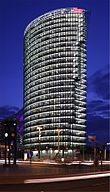
Current business areas (post 2007) DB Dienstleistungen · DB Fernverkehr · DB Netze Energie · DB Netze Fahrweg · DB Netze Personenbahnhöfe · DB Netze Projektbau · DB Regio · DB Schenker Rail pre 2009 'Railion' · DB Schenker Logistics · DB Stadtverkehr · DB Station&ServiceServices Intercity-Express · Intercity · InterRegio (defunct) · Interregio-Express · Regional-Express · Regionalbahn · S-Bahn · DB City Night Line · DB AutoZug · Metropolitan (defunct)International Services EuroCity · ThalysFormer business areas (2000-07) United Kingdom DB Schenker Rail (UK) · Arriva Trains Wales · Chiltern Railways · CrossCountry · London Overground · Tyne and Wear Metro · Grand CentralHistory Related topics Rail transport in Germany · BahnTower · Bahn TV · BahnCard
Categories:- London articles in need of updating
- London Overground
- London Rail
- 2007 establishments in England
- Croydon 2020
- Railway operators in London
- Railway infrastructure in London
- Train operating companies
- Modes of transport in London
- Electric railways in the United Kingdom
Wikimedia Foundation. 2010.

